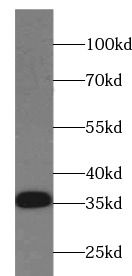Products
DDIT4-specific antibody
| Synonyms: | DNA damage-inducible transcript 4 protein|HIF-1 responsive protein RTP801|Protein regulated in development and DNA damage response 1 (REDD-1)|DDIT4|REDD1|RTP801 antibody | ||
| Catalogue No.: | FNab07228 | Reactivity: | Human, Mouse, Rat |
| Host: | Rabbit | Tested Application: | ELISA, IHC, IP, WB |
| Clonality: | polyclonal | Isotype: | IgG |
| Size | Price |
|---|---|
| 100µg | Inquiry |
- SPECIFICATIONS
- CITATIONS
- FIGURES
- CONDITIONS
- FAQS
- Product Name
- DDIT4-specific antibody
- Catalogue No.
- FNab07228
- Size
- 100μg
- Form
- liquid
- Purification
- Immunogen affinity purified
- Purity
- ≥95% as determined by SDS-PAGE
- Clonality
- polyclonal
- Isotype
- IgG
- Storage
- PBS with 0.02% sodium azide and 50% glycerol pH 7.3, -20℃ for 12 months(Avoid repeated freeze / thaw cycles.)
- Immunogen
- DNA-damage-inducible transcript 4
- Alternative Names
- DNA damage-inducible transcript 4 protein|HIF-1 responsive protein RTP801|Protein regulated in development and DNA damage response 1 (REDD-1)|DDIT4|REDD1|RTP801 antibody
- UniProt ID
- Q9NX09
- Observed MW
- 35 kDa
- Tested Applications
- ELISA, IHC, IP, WB
- Recommended dilution
- WB: 1:500-1:5000; IP: 1:200-1:2000; IHC: 1:50-1:200
 PC-3 cells were subjected to SDS PAGE followed by western blot with FNab07228(REDD1 antibody) at dilution of 1:1000
PC-3 cells were subjected to SDS PAGE followed by western blot with FNab07228(REDD1 antibody) at dilution of 1:1000
 IP Result of anti-REDD1 specific (IP:FNab07228, 3ug; Detection:FNab07228 1:500) with MCF-7 cells lysate 2500ug.
IP Result of anti-REDD1 specific (IP:FNab07228, 3ug; Detection:FNab07228 1:500) with MCF-7 cells lysate 2500ug.
 Immunohistochemistry of paraffin-embedded human breast cancer using FNab07228(REDD1 antibody) at dilution of 1:100
Immunohistochemistry of paraffin-embedded human breast cancer using FNab07228(REDD1 antibody) at dilution of 1:100
- Background
- REDD1, also named as RTP801 and DDIT4, belongs to the DDIT4 family.Its function:Regulates cell growth, proliferation and survival via inhibition of the activity of the mammalian target of rapamycin complex 1(mTORC1). Inhibition of mTORC1 is mediated by a pathway that involves DDIT4/REDD1, AKT1, the TSC1-TSC2 complex and the GTPase RHEB. Plays an important role in responses to cellular energy levels and cellular stress, including responses to hypoxia and DNA damage. Regulates p53/TP53-mediated apoptosis in response to DNA damage via its effect on mTORC1 activity. Its role in the response to hypoxia depends on the cell type; it mediates mTORC1 inhibition in fibroblasts and thymocytes, but not in hepatocytes(By similarity). Required for mTORC1-mediated defense against viral protein synthesis and virus replication(By similarity). Inhibits neuronal differentiation and neurite outgrowth mediated by NGF via its effect on mTORC1 activity. Required for normal neuron migration during embryonic brain development. Plays a role in neuronal cell death.This antibody is specific to the REDD1.
- Journal:
- Preprints
- Cited Date:
- 2021-12-03
- Product:
How many times can antibodies be recycled?
First, usually it's not suggested to recycle antibodies. After use, buffer system of antibodies has changed. The storage condition of recycled antibodies for different customers also varies. Thus, the performance efficiency of recycled antibodies can’t be guaranteed. Besides, FineTest ever conducted the antibody recycling assay. Assay results show recycling times of different antibodies also varies. Usually, higher antibody titer allows more repeated use. Customers can determine based on experimental requirements.
Notes: After incubation, we recycle rest antibodies to centrifuge tube and store at 4℃. High titer antibodies can be stored for a minimum of one week. Reuse about three times.
What are components of FineTest antibody buffer?
Components of FineTest antibody buffer are usually PBS with proclin300 or sodium azide, BSA, 50% glycerol. Common preservative is proclin300 or sodium azide, which is widely applied in the lab and industry.
How about the storage temperature and duration of FineTest antibodies?
Most antibodies are stored at -20℃. Directly-labeled flow cytometry antibodies should be stored at 2 - 8℃. The shelf life is one year. If after sales issues for purchased antibodies appear, return or replacement is available. Usually, antibodies can be still used after the one-year warranty. We can offer technical support services.
Is dilution required for FineTest antibodies? What’s the dilute solution?
Directly-labeled flow cytometry antibodies are ready-to-use without dilution. Other antibodies are usually concentrated. Follow the dilution ratio suggested in the manual. Dilute solution for different experiments also varies. Common antibody dilution buffers are acceptable(e.g. PBST, TBST, antibody blocking buffer).
How to retrieve antibodies for immunohistochemistry?
Common retrieval buffers: Tris-EDTA Buffer(pH 9.0); Citrate Buffer(pH 6.0)
Heat induced antibody retrieval:
Method 1: Water-bath heating: Put the beaker with retrieval buffer and slide in the boiling water bath. Keep the boiling state for 15min. Naturally cool to room temperature;
Method 2: Microwave retrieval: Put the beaker with retrieval buffer and slide in the microwave oven. Heat at high power for 5min, Switch OFF for 3min, Heat at medium power for 5min. Naturally cool to room temperature.
How to choose secondary antibodies?
(1) Secondary antibodies react with primary antibodies. Thus, secondary antibodies should be against host species of primary antibodies. E.g. If the primary antibody is derived from rabbit, the relevant secondary antibody should be against rabbit. E.g. goat anti rabbit or donkey anti rabbit.
(2) Choose secondary antibody conjugates according to the experimental type, e.g. ELISA, WB, IHC etc. Common enzyme conjugated secondary antibodies are labelled by HRP, AP etc. Fluorescin or dye labelled secondary antibodies are applied in immunofluorescence and flow cytometry(e.g. FITC, Cy3).
